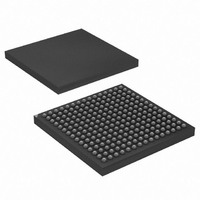AT91CAP7E-NA-ZJ Atmel, AT91CAP7E-NA-ZJ Datasheet - Page 213

AT91CAP7E-NA-ZJ
Manufacturer Part Number
AT91CAP7E-NA-ZJ
Description
MCU CAP7 FPGA 225LFBGA
Manufacturer
Atmel
Series
CAP™r
Specifications of AT91CAP7E-NA-ZJ
Core Processor
ARM7
Core Size
16/32-Bit
Speed
80MHz
Connectivity
EBI/EMI, FPGA, IrDA, SPI, UART/USART, USB
Peripherals
DMA, POR, PWM, WDT
Number Of I /o
32
Program Memory Size
256KB (256K x 8)
Program Memory Type
ROM
Ram Size
160K x 8
Voltage - Supply (vcc/vdd)
1.08 V ~ 1.32 V
Data Converters
A/D 8x10b
Oscillator Type
Internal
Operating Temperature
-40°C ~ 85°C
Package / Case
225-LFBGA
Processor Series
AT91Mx
Core
ARM7TDMI
Data Bus Width
32 bit
3rd Party Development Tools
JTRACE-ARM-2M, MDK-ARM, RL-ARM, ULINK2
Lead Free Status / RoHS Status
Lead free / RoHS Compliant
Eeprom Size
-
Lead Free Status / Rohs Status
Details
Available stocks
Company
Part Number
Manufacturer
Quantity
Price
- Current page: 213 of 520
- Download datasheet (11Mb)
Figure 24-6. Master Clock Controller
24.2.3
24.2.4
Figure 24-7. USB Clock Controller
8549A–CAP–10/08
Processor Clock Controller
USB Clock Controller
MAINCK
PLLACK
PLLBCK
SLCK
The PMC features a Processor Clock Controller (PCK) that implements the Processor Idle
Mode. The Processor Clock can be disabled by writing the System Clock Disable Register
(PMC_SCDR). The status of this clock (at least for debug purposes) can be read in the System
Clock Status Register (PMC_SCSR).
The Processor Clock PCK is enabled after a reset and is automatically re-enabled by any
enabled interrupt. The Processor Idle Mode is achieved by disabling the Processor Clock which
is automatically re-enabled by any enabled fast or normal interrupt, or by the reset of the prod-
uct. When the Processor Clock is disabled, the current instruction is finished before the clock is
stopped, but this does not prevent data transfers from other masters of the system bus.
The USB Source Clock is always generated from the PLL B output. If using USB, the user must
program the PLLB to generate a 96 MHz signal (with an accuracy of ± 0.25%) and then further
divide this clock by 2 to generate a 48 MHz clock by programming the appropriate value into the
USBDIV bits in CKGR_PLLBR (see
When the PLL B output is stable, i.e., the LOCKB is set:
• The USB host clock can be enabled by setting the UHP bit in PMC_SCER. To save power on
• The USB device clock can be enabled by setting the UDP bit in PMC_SCER. To save power
Source
Clock
USB
this peripheral when it is not used, the user can set the UHP bit in PMC_SCDR. The UHP bit
in PMC_SCSR gives the activity of this clock. A USB host port requires both the 12/48 MHz
signal and the Master Clock. The Master Clock may be controlled via the Master Clock
Controller.
on this peripheral when it is not used, the user can set the UDP bit in PMC_SCDR. The UDP
bit in PMC_SCSR gives the activity of this clock. The USB device port require both the 48
MHz signal and the Master Clock. The Master Clock may be controlled via the Master Clock
Controller.
PMC_MCKR
CSS
USBDIV
Divider
/1,/2,/4
PMC_MCKR
Master Clock
Prescaler
PRES
Figure
UDP
UHP
24-7).
UDP Clock (UDPCK)
UHP Clock (UHPCK)
MCK
To the Processor
Clock Controller (PCK)
AT91CAP7E
213
Related parts for AT91CAP7E-NA-ZJ
Image
Part Number
Description
Manufacturer
Datasheet
Request
R

Part Number:
Description:
Customizable Microcontroller
Manufacturer:
ATMEL Corporation
Datasheet:

Part Number:
Description:
DEV KIT FOR AVR/AVR32
Manufacturer:
Atmel
Datasheet:

Part Number:
Description:
INTERVAL AND WIPE/WASH WIPER CONTROL IC WITH DELAY
Manufacturer:
ATMEL Corporation
Datasheet:

Part Number:
Description:
Low-Voltage Voice-Switched IC for Hands-Free Operation
Manufacturer:
ATMEL Corporation
Datasheet:

Part Number:
Description:
MONOLITHIC INTEGRATED FEATUREPHONE CIRCUIT
Manufacturer:
ATMEL Corporation
Datasheet:

Part Number:
Description:
AM-FM Receiver IC U4255BM-M
Manufacturer:
ATMEL Corporation
Datasheet:

Part Number:
Description:
Monolithic Integrated Feature Phone Circuit
Manufacturer:
ATMEL Corporation
Datasheet:

Part Number:
Description:
Multistandard Video-IF and Quasi Parallel Sound Processing
Manufacturer:
ATMEL Corporation
Datasheet:

Part Number:
Description:
High-performance EE PLD
Manufacturer:
ATMEL Corporation
Datasheet:

Part Number:
Description:
8-bit Flash Microcontroller
Manufacturer:
ATMEL Corporation
Datasheet:

Part Number:
Description:
2-Wire Serial EEPROM
Manufacturer:
ATMEL Corporation
Datasheet:











